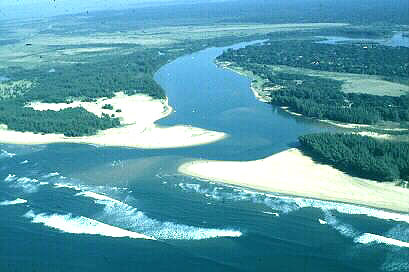
(Courtesy of Ricky Taylor)

|
The St Lucia Estuary is located in South Africa along the east coast. It is Africa's largest coastal lagoon. The Estuary covers 135 square miles (350 sq km) - yet is very shallow, with an average depth of only 35 inches (90 cm). At the southern end, a narrow fourteen-mile (22 km) channel connects the main water-body of Lake St. Lucia to the Indian Ocean, while all the main rivers, the Mkhuze, Nyalazi, Mzinene and Hluhluwe Rivers, flow into the northern end of the system. When rains are good and the rivers flow strongly, there is an outflow from St Lucia to the sea and the system may have only a very low salt content. However, during periods of extended drought the rivers stop flowing and lake level falls to below that of the sea. Inflowing seawater replaces the water lost through evaporation. Salt accumulates, and at the peak of an extreme drought the salt concentration reaches 120 parts per thousand in the northern parts of the lake. This is more than three times as salty as the sea. As salinity changes, so does the ecological nature of St Lucia. Low salinities favor submerged water plants that attract numbers of ducks. Salinity closer to seawater is optimum for estuarine fish that have spawned in the sea and seek shelter and the abundant food resources of the estuary. During the high salinities, phytoplankton and zooplankton exploit the rich nutrient concentrations of the hypersaline waters, providing an abundance of food for thousands of lesser flamingoes. The lake, and the adjacent freshwater wetlands, provide a home for 800 hippopotamuses and well over a thousand large crocodiles. It supports South Africa's largest breeding colony of white pelicans. Adjacent to the estuary there are elephants, black rhinoceroses, buffalo and a variety of antelope in an area of great scenic beauty. Many nature lovers visit St Lucia each year, and tourism to the park is a major contributor to the economy of the region. Some natural products, which are no longer available outside the protected area, are harvested by the local Zulu people. The most noteworthy is Juncus kraussii, a salt-marsh rush known as iNcema in Zulu, which is used to weave traditional mats.
|
 Cretaceous cliffs |
 Crocodile |
 Flamingoes |
 Hippopotamus |
 Lake Vista |
 Mangroves |
 Mangrove whelk |
 Ncema |
 Pelicans |